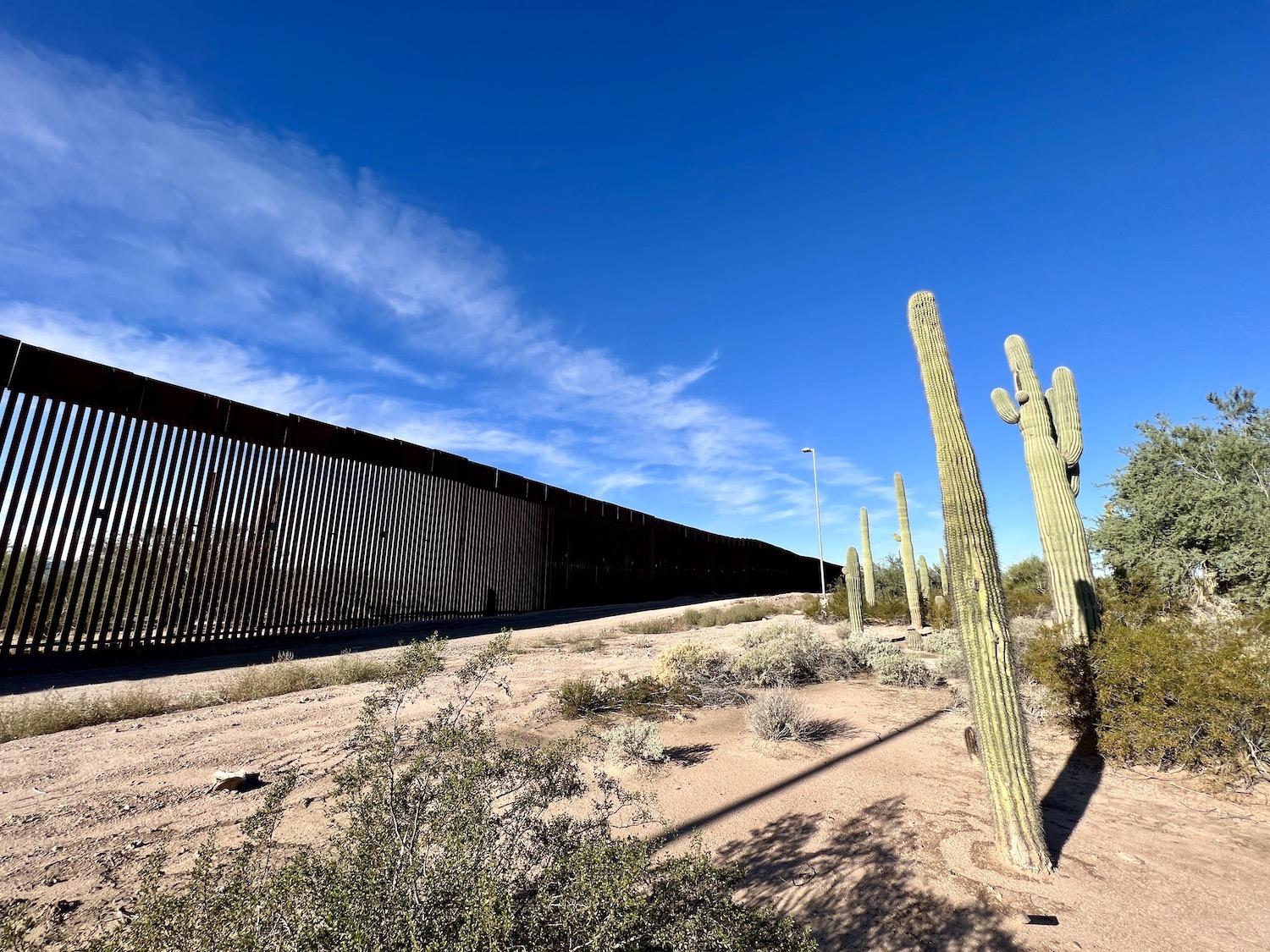
Saguaro cacti front the border wall that runs along the southern boundary of Organ Pipe Cactus National Monument where Arizona meets Mexico/Jennifer Bain
The Challenges (And Rewards) Of Visiting Organ Pipe Cactus National Monument
By Jennifer Bain
Thirty-one species of cacti live in the starkly beautiful Organ Pipe Cactus National Monument in the Sonoran Desert, along with bighorn sheep, pronghorns, javelinas, kangaroo rats, rare pupfish, and all kinds of reptiles and birds. But the green desert is also home to a 30-mile stretch of America’s steel border wall, and warning signs had this traveler anxious that “smuggling and illegal immigration may be encountered in this area.”
To make sense of the deeper issues at play in this complex park, I turned to two artists and a humanitarian group.
As I drove with my 10-year-old son by water stations maintained by Humane Borders to help save lives, I wondered what I would actually do if faced with desperate migrants on perilous illegal journeys. Would I avoid them and call 911 as directed? Or would I share the water in the trunk and the power bars in my backpack but stop short of breaking the law by inviting them into our vehicle?
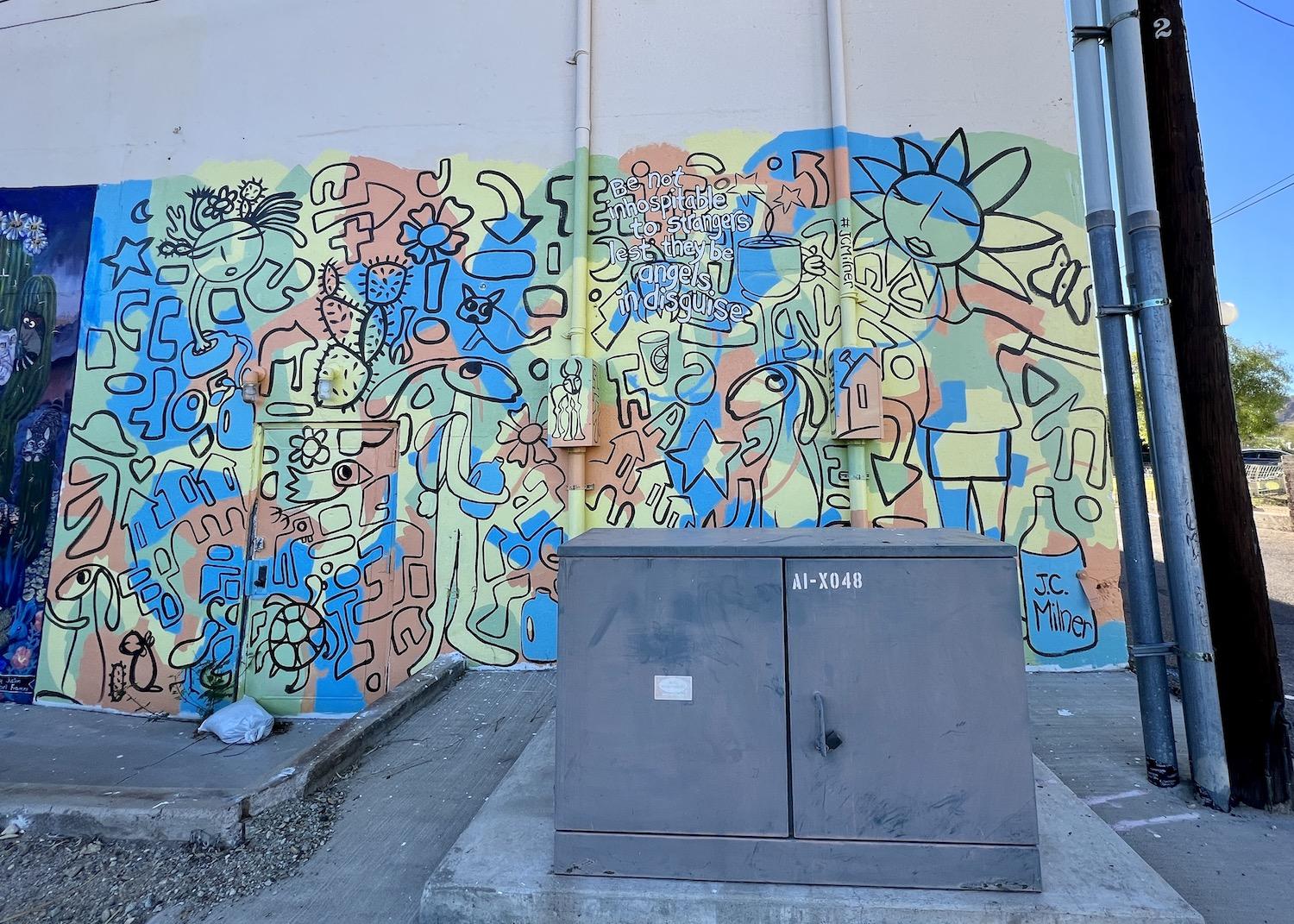
A mural in Ajo by artist J.C. Milner quietly honors those who provide life-saving water to migrants in the desert/Jennifer Bain
My mind kept returning to a mural I'd seen in an alley back in the town of Ajo featuring J.C. Milner’s whimsical jackrabbits frolicking among other creatures. Look closely and you’ll see a rabbit and a desert angel subversively carrying water jugs. “Be not inhospitable to strangers lest they be angels in disguise,” the mural says in a quote that was popularized by George Whitman at the Shakespeare and Company bookstore in Paris but originates in Hebrews 13:2 in the Bible.
I also ruminated about a second outdoor mural in the International Sonoran Desert Alliance collection, this one by Ajo artist/activist Maria Singleton that shows human silhouettes moving through the desert by moonlight while spouting butterfly wings. It, too, has a written message: “Migration, for all living creatures, is a move from scarcity toward plenty ---- from despair toward hope. Humans have their own migratory impulse, based on the same fundamental desire coded within all living things — survival.” The quote is surrounded by all sizes, shapes and colors of butterflies.
Singleton volunteers with the Ajo Samaritans to provide water and other humanitarian aid to travelers, regardless of immigration status, in the borderlands near Ajo. “Oh gosh, I couldn’t live with myself knowing somebody died of thirst when I have running tap water,” she told us during a tour of the former copper mining town.
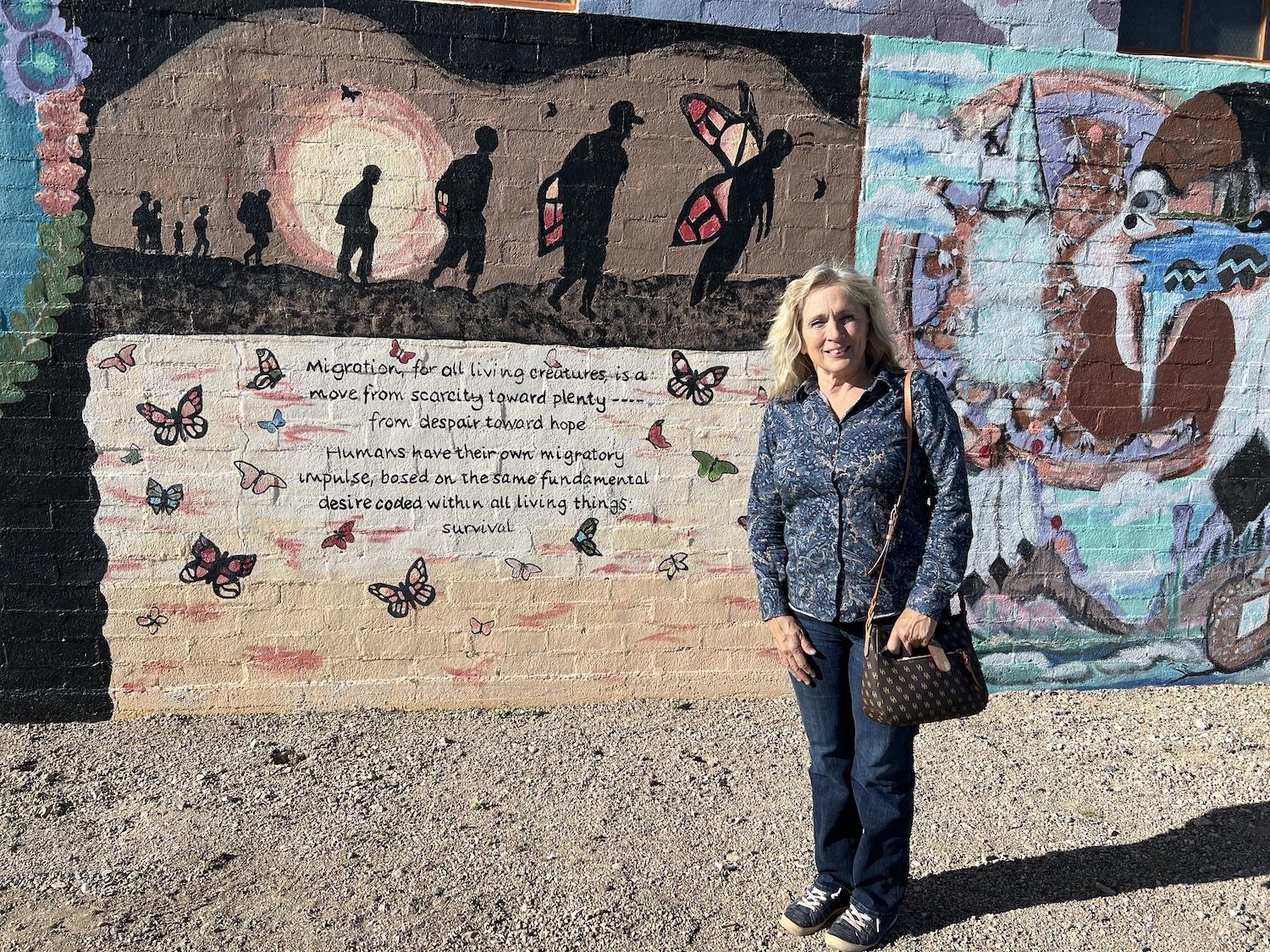
Ajo artist Maria Singleton stands by her mural that speaks to the complex issue of migration in the Borderlands of Arizona and Mexico/Jennifer Bain
In a sobering post on its website, Humane Borders reports that as of November 2021, 3,790 immigrants have died trying to cross the Arizona Sonoran desert, and many more haven’t been found. I hear elsewhere that in Organ Pipe Cactus alone, human remains — some recently deceased, some dead for years, many never identified — are quietly recovered each year but that those discoveries don’t typically merit National Park Service news releases.
I like to know the full and nuanced story of the places I visit, but don’t hear a word about migrant deaths at the park's Kris Eggle Visitor Center, where I watch a short film about how this public land is a place “where edges meet,” peruse the exhibits, stroll the nature trail, and stop by a sobering memorial for the park ranger whose name is attached to the center. Eggle was just 28 when he was shot and killed here on August 9, 2002, while pursuing members of a drug cartel who had committed a string of murders in Mexico.
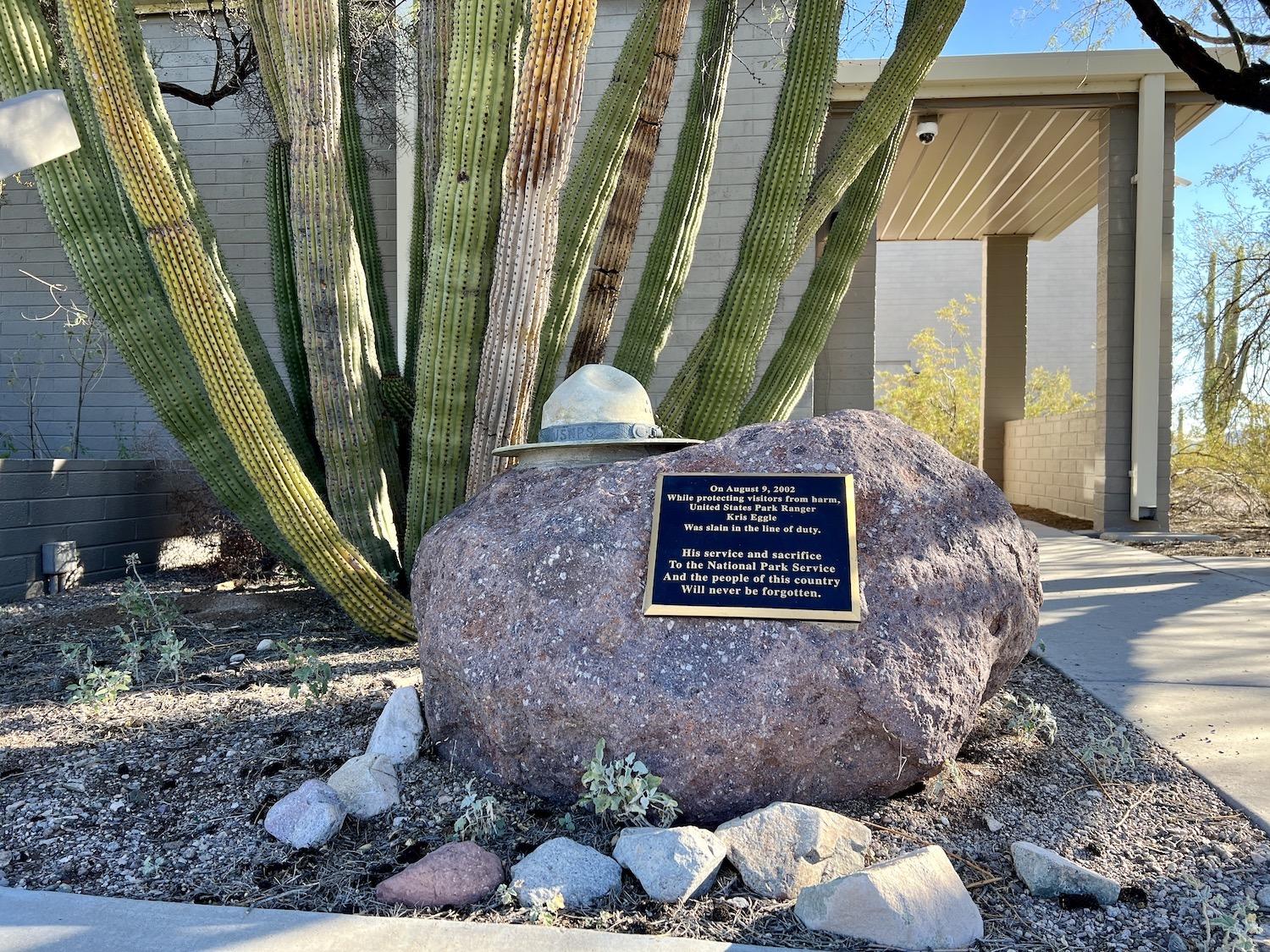
A memorial for murdered Ranger Kris Eggle can be found under an organ pipe cactus at the Kris Eggle Visitor Center/Jennifer Bain
After the beloved ranger’s murder, vehicle barriers were built along the border, and for an unfortunate spell, Organ Pipe Cactus was known as the most dangerous park in America and much of it was closed. The park fully reopened in 2014 with a plan between the NPS and Border Patrol to do surveillance and erase hundreds of miles of illegal roads.
The monument's website has a safety section. When I picked up the annual Cactus Chronicle newspaper at the visitor center, I read more safety instructions for visiting this 516-square-mile desert park and UNESCO Biosphere Reserve that logged 190,848 visitors in 2021, down from a record high of 415,400 in 1970.
“People do cross the border, but national park visitors are unlikely to encounter illegal activity in the monument,” the Chronicle explained. “Migrants and smugglers want to avoid contact with other people. In rare instances when migrants or smugglers approach a visitor, it is usually because they are lost, need water, or are in medical distress.” The park newspaper then advised against providing water or food as people “may continue further into the desert and become distressed, needing assistance in an area where there is no help available.”
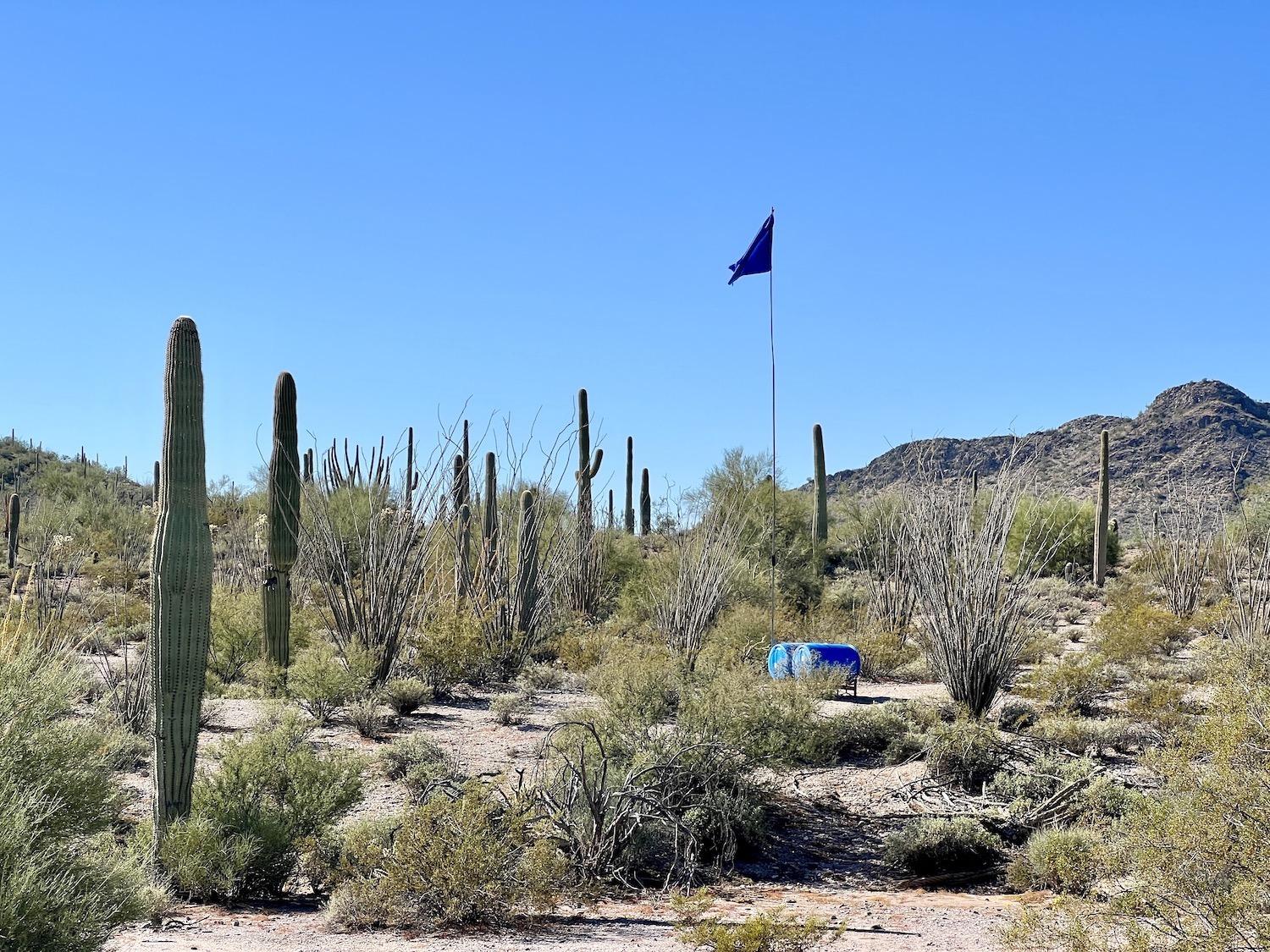
One of the Humane Borders water stations in Organ Pipe Cactus National Monument/Jennifer Bain
I later ran that last troubling point by University of California-Davis political science professor Brad Jones, a volunteer with Humane Borders. Jones said that while in principle it makes sense, migrants aren’t likely to wander up to people unless they’re nearing a “life or death situation.”
“At that point,” Jones said, “withholding water would be, to put it bluntly, inappropriate.”
Humane Borders strives “to save desperate people from a horrible death by dehydration and exposure and to create a just and humane environment in the borderlands.” It also maintains a migrant death map in partnership with the Pima County Office of the Medical Examiner.
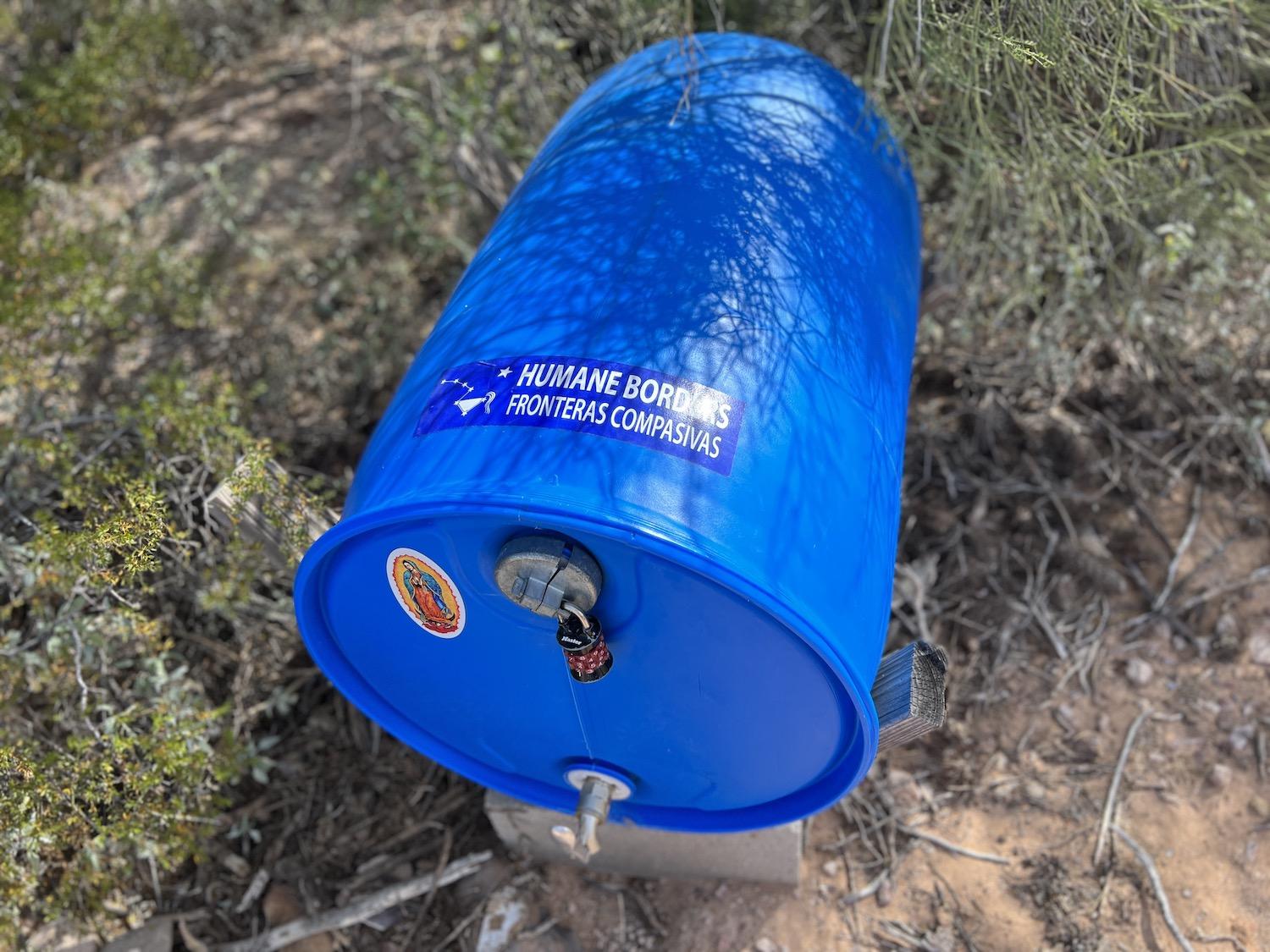
Humane Borders does regular water quality checks on its water stations/Jennifer Bain
The NPS allows the non-profit group to put water stations — six at the moment — in Organ Pipe Cactus under a special-use permit. Each includes a 55-gallon tank placed under a blue flag for visibility. Volunteers do regular water quality tests and clean up any “migrant artifacts” (trash) to keep the desert as clean as possible, but admit the biggest challenge is enduring vandalism from hate and vigilante groups.
“We don’t advertise the locations of these stations for obvious relations,” said Jones, who used to teach in Tucson, “but they’re very visible and easy to see if driving or hiking.” He’s right — we spotted two water stations in two days within steps of the scenic roads that wind through the park.
There are three main scenic roads in Organ Pipe Cactus. Ajo Mountain Drive is currently closed for repairs, most of North Puerto Blanco Drive requires a high-clearance vehicle, and South Puerto Blanco Drive is the most accessible. Hiking trails off each road showcase the monument's natural and cultural heritage, and ties to ranching and mining. There are some interpretive signs, and plans to work with tribal partners to tell important stories about Indigenous connections to this land as the 250th anniversary of the signing of the Declaration of Independence (America 250) approaches in 2026.
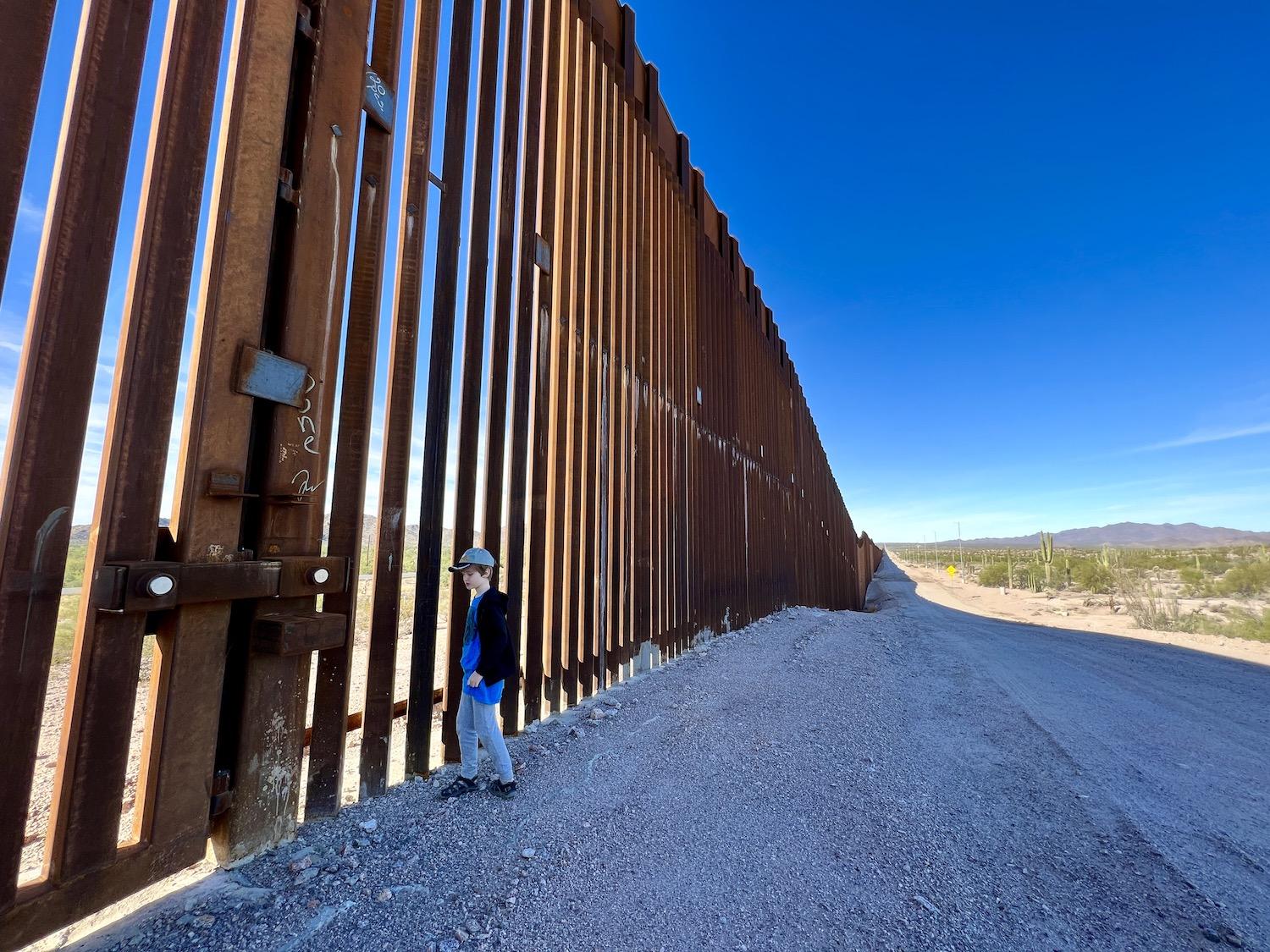
Writer Jennifer Bain's son experiences the border wall along the southern boundary of Organ Pipe Cactus National Monument/Jennifer Bain
Driving down South Puerto Blanco Road to get to Quitobaquito Springs, a desert pond that’s home to the rare Quitobaquito pupfish, we traveled parallel to the stark, 30-foot-tall border wall for miles and past a place known as Monument Hill that's of great spiritual and cultural importance to the Tohono O'odham Nation. The 13-minute video Healing the US Mexico Border (Voces Indígenas de la Frontera) by Halting and Healing the Border Disorder delves into the Indigenous community's feelings about the wall.
The wall construction drew headlines in 2019 when Donald Trump was president and environmental laws were waived to get it built fast. Heavy machines tore up precious desert, harming cacti, trees and shrubs, potentially interfering with wildlife migration, and desecrating land that’s important to the Tohono O’odham Nation.
Humane Borders, for one, doesn’t believe the wall stops migrants from illegally entering the country — it just pushes them into more dangerous crossings in the further reaches of the Western desert and on military land where they can’t place water stations.
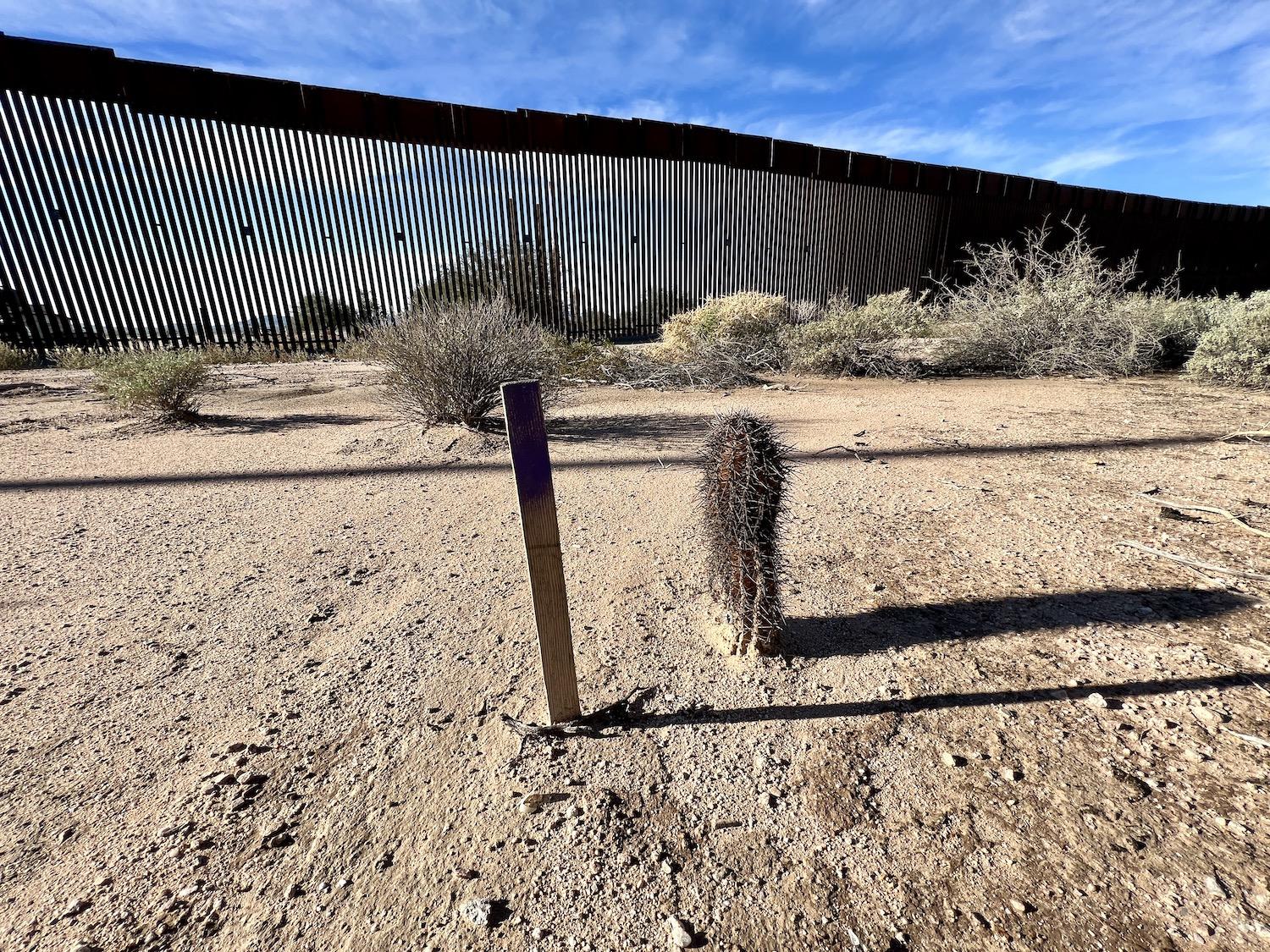
A wooden marker stands beside an ailing cactus that was relocated when the border wall was built/Jennifer Bain
As we drove along the wall, I learned that some displaced cacti had been relocated.
“Restoration area,” a few random signs said beside clearly ailing plants. “Please help it grow!”
Near the parking area for Quitobaquito Springs, we peeked through slats in the steel wall to see one of the simple stone obelisks that once dominated here as border markers. The English side faced me but I couldn’t see the Spanish side. After the obelisk era came barbed-wire fence to keep livestock and vehicles out of this desert wilderness. Vehicle barriers went up in 2004 to stop people from driving around the U.S. customs office in Lukeville. Remants of these barriers can still be found along South Puerto Blanco Drive — and they're still detailed on the monument's website. From what I can see, the border wall still isn't mentioned — a missed opportunity to explain something that looms large over this public land.
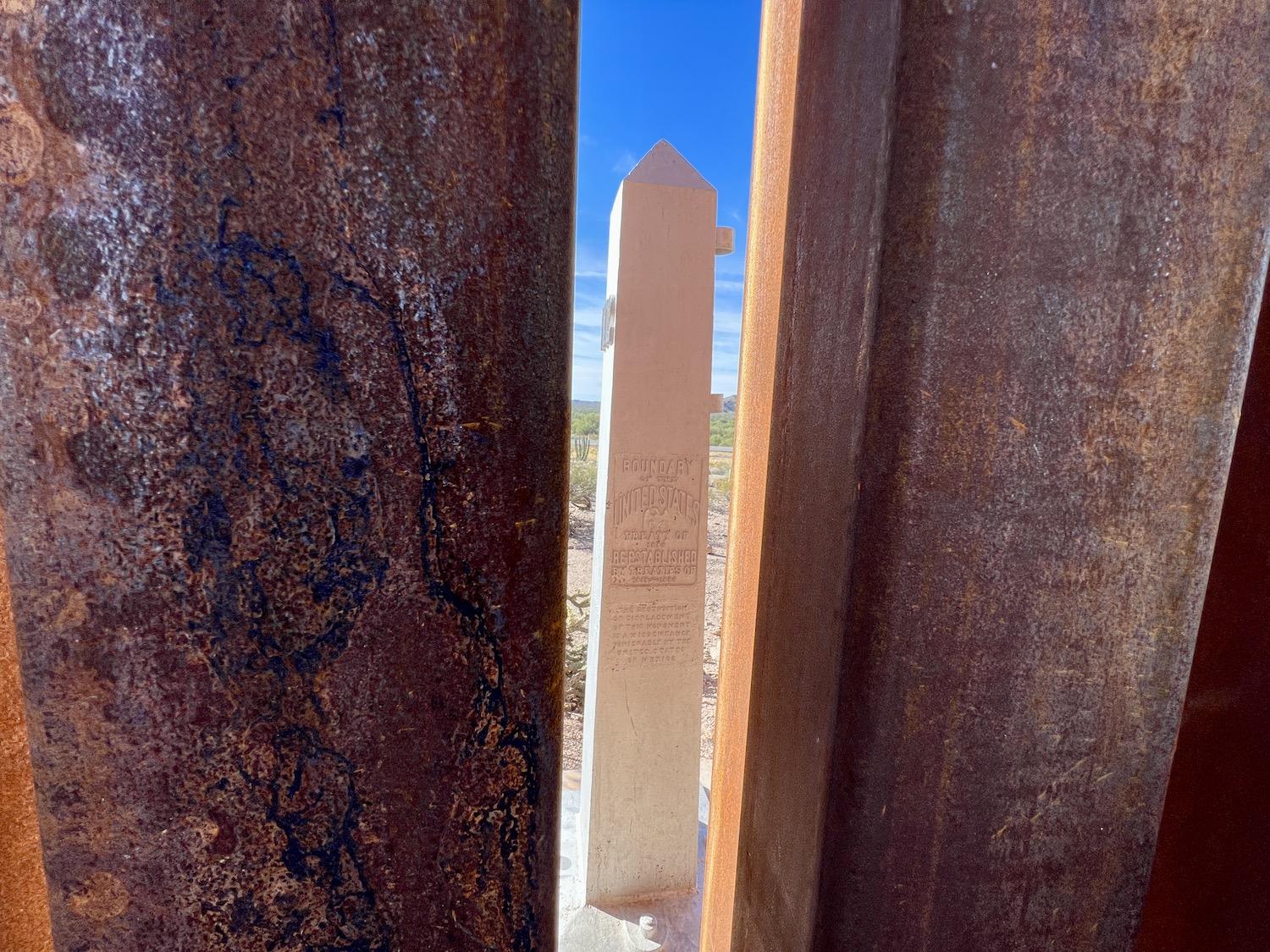
Beautiful stone obelisks once marked the U.S.-Mexico border in Organ Pipe Cactus National Monument/Jennifer Bain
Driving from the visitor center to Quitobaquito Springs and back with Jessica Pope, I learned that the interpretation, education and community engagement division manager for Organ Pipe Cactus would be making a presentation that night to a Road Scholar group that was staying at the Sonoran Desert Inn and Conference Center in Ajo (where we stayed) and exploring the park on an "educational travel and learning adventure."
Pope would divide the travelers into three groups and present them with a management scenario — should the park allow more blue light rescue beacons to be placed in wildlife areas to potentially save the lives of migrants in distress?
Some people would be tasked with playing wildlife biologists concerned about how skittish Sonoran Pronghorns might be impacted by flashing lights. Others would be law enforcement officers concerned about smugglers, human traffickers and the human remains that have been found in the desert. The final group would take on the roles of the public, subdividing into pro-immigration and anti-immigration camps. A superintendant for each group would consider all the input and make a decision.
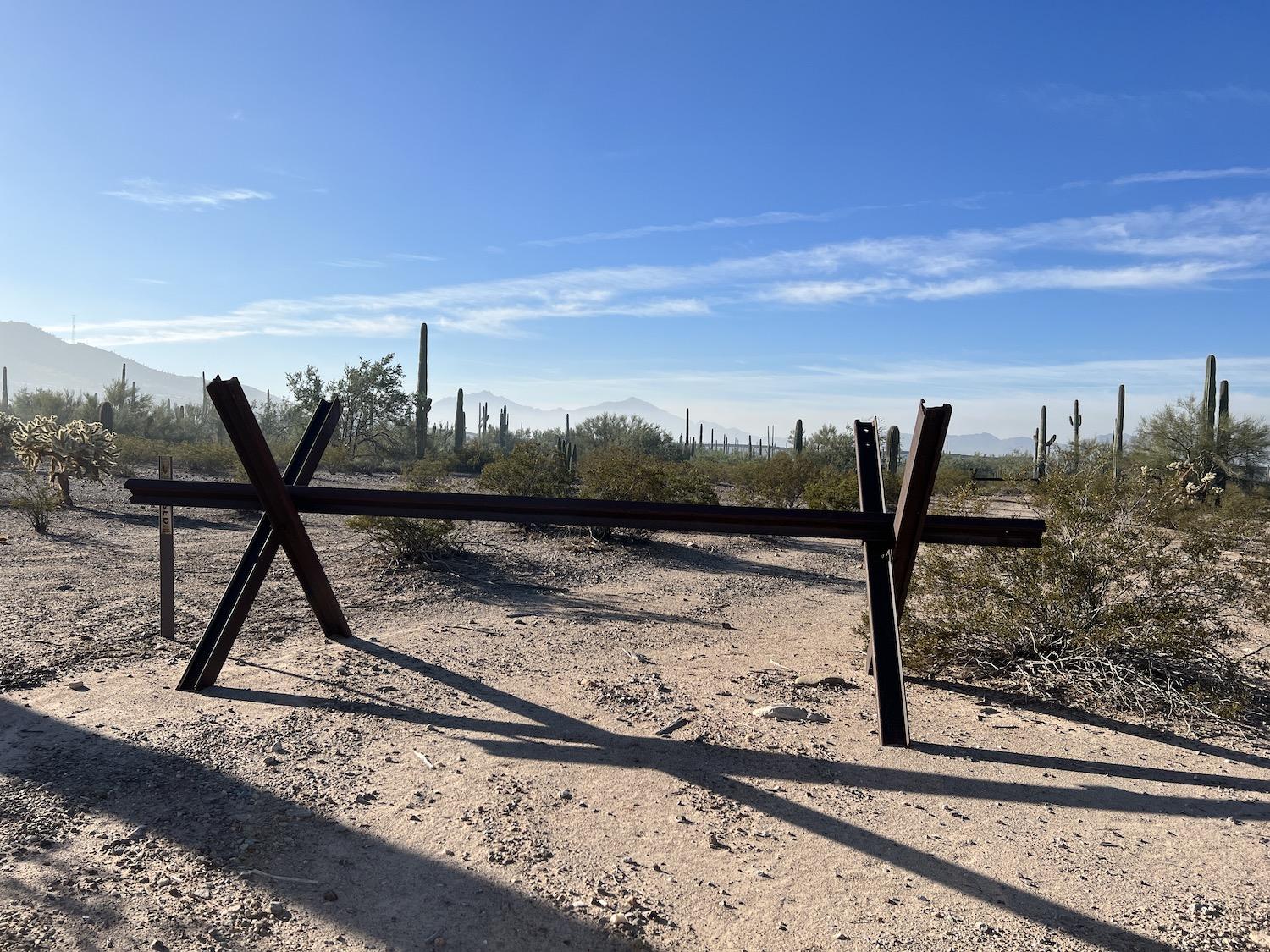
Some of the vehicle barriers that once marked the border with Mexico can still be found along South Puerto Blanco Drive/Jennifer Bain
Invariably when Pope does this exercise, one group comes out in favor of the beacons, one decides against them, and the third desperately tries to find a compromise.
"The conversations afterwards in the unpacking of the exercise are really fascinating," Pope said. "They do say, `So how does this work? It’s hard.' It is really hard because we’re balancing all these things that matter and when you put it up against human life, it’s difficult. It’s really difficult."
In the real world, she added, "we just hear a lot of sound bites, and then you get down here and you recognize that it’s way more complex."
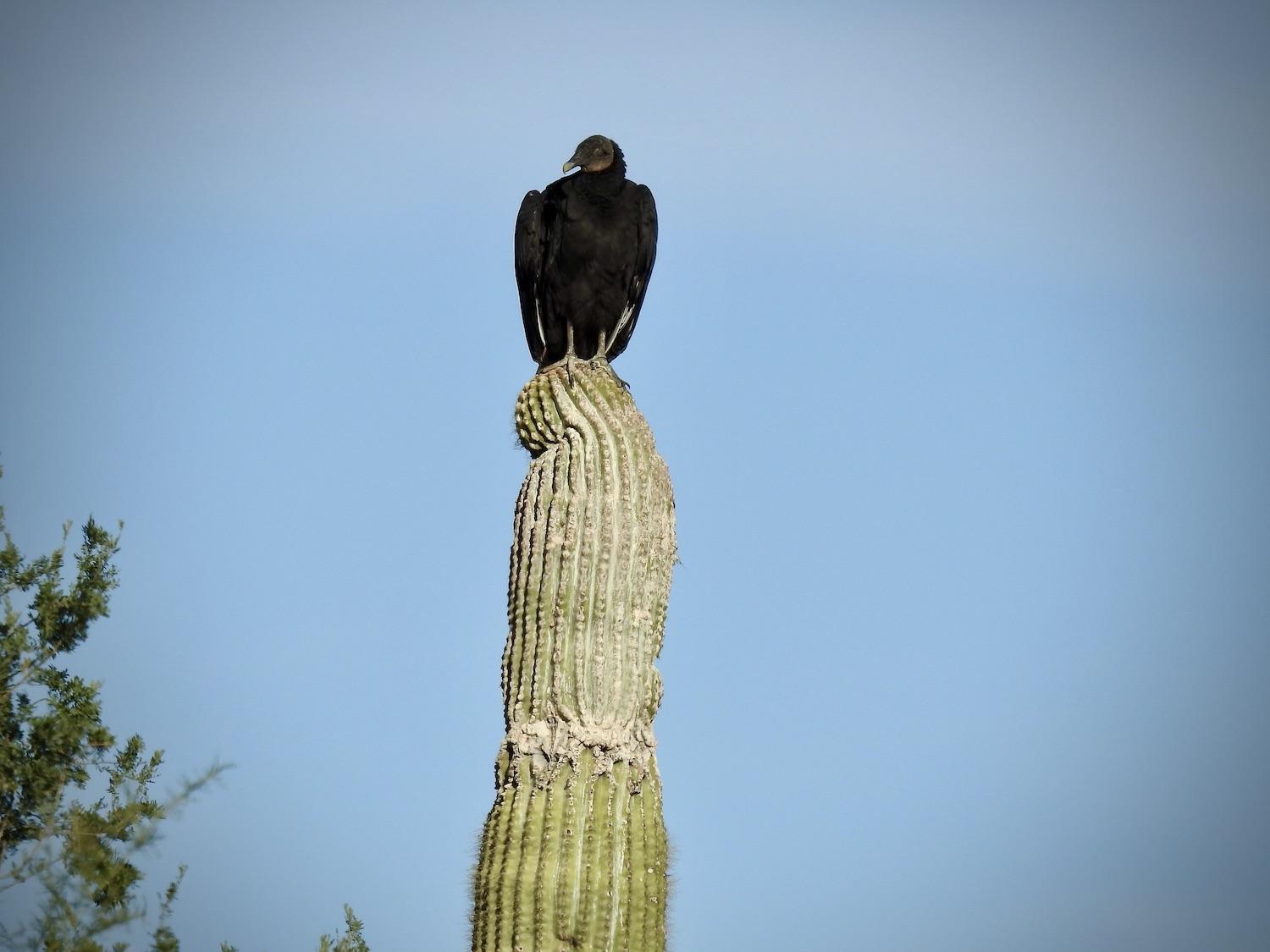
A turkey vulture rests on a saguaro cactus in Organ Pipe Cactus National Monument/Jennifer Bain
I would have loved to crash the Road Scholar gathering, but made do with checking out their website and noting how they position one of their Organ Pipe Cactus days: "During our stop, we’ll take a short walk to a portion of the `wall'/fence that is in place to separate Sonoyta, Mexico and the United States. A current topic of interest, this will be an opportunity to see for oneself the reality of the edifice." These are clearly my kind of travelers — the ones who are aren't afraid to dig into the good, the bad and the ugly about a destination for a richer, deeper and more authentic experience.
I suspect they'd agree that even a little interpretive signage at Organ Pipe Cactus about the wall and the humanitarian and environmental issues connected to it would go a long way to educating visitors and not just scaring them with safety warnings. Dark tourism — deliberately travelling to places where the darkest events in human history have unfolded, as the Washington Post puts it — is a growing phenomenom.
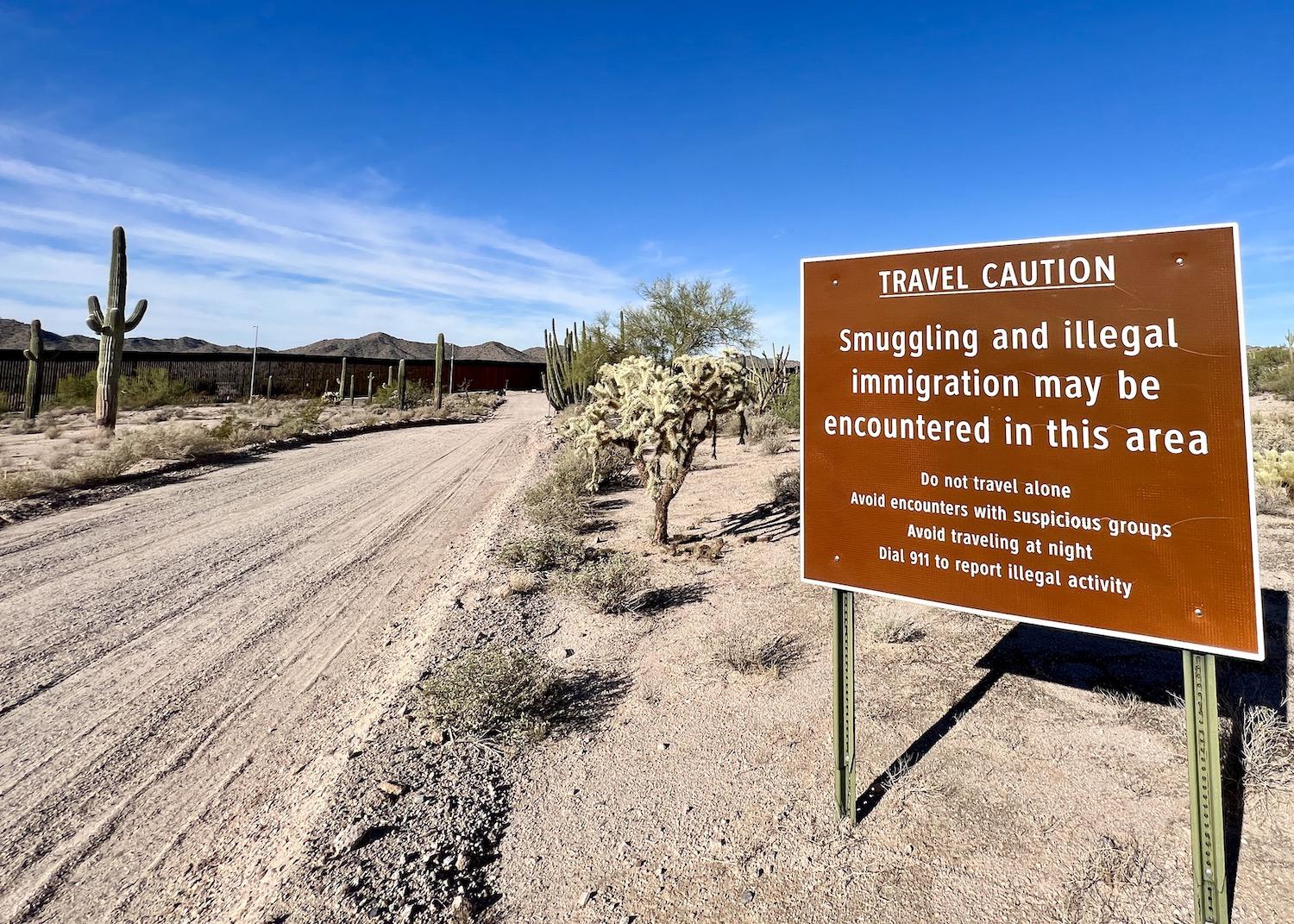
A "travel caution" sign sits along South Puerto Blanco Road on the way to Quitobaquito Springs and within view of the border wall/Jennifer Bain
Needless to say, we didn't run into any migrants in the national monument during our two days there, but did see an endless stream of vehicles driving straight through the park and over the border into Mexico for motorcycle rallies and beach holidays. My son got to touch a border wall he'd heard about but didn't believe was real, and got a crash course in humanitarianism. I left grappling with complex issues and regretting that we didn't have time for a deeper dive into Organ Pipe Cactus this time around.
"All national parks in one way or another are going to be dangerous," Pope rightly told me. "Situational awareness is important wherever you go, but I would hope that despite the border complexities, despite the hard things that are happening down here, visitors would still want to come. The Sonoran Desert is an incredibly beautiful place. It's a unique landscape. It's a biologically diverse landscape. It's an opportunity to sink into solitude and wilderness that is rarely experienced in a lot of places anymore these days. So don’t let the hard things keep you away."
I never do.


Comments
If you encounter a group of pedestrians in the desert do you think you could tell the difference between the thirsty "migrants" and the armed and dangerous cartel operator who is smuggling them? Do you think that smuggler wants you around so you can later report the group's location, size and direction of travel to law enforcement?
If you encounter a single pedestrian or a couple of pedestrians in the desert do you think you could determine if he or she is a lost and desperate "migrant" or an armed and dangerous cartel drug smuggler who is in a little over their head? Do you think an armed cartel drug smuggler might be interested in robbing you? Raping you before hoping back over the border where there is effectively no law enforcement? Do you think a smuggler would hesitate to send out a woman or child to lure you in?
And are you willing to risk the life of your 10 year old in the car in the name of humanitarianism? How about a conversation of that moral decision?
You think the NPS closed off half of Organ Pipe for years as an academic exercise? Understand this: Just taking a picture of a cartel operator could get you killed. The cartels have spotters in Mexico using binoculors, telescopes and drones to watch the border area. Any contact with pedestrians (not hikers) along our desert border is an extraordinarily dangerous situation. The Border Patrol recovers bodies all the time, and the deceased did not always die of natural causes. Any BP agent will tell you that there are scores more bodies out there that have been devoured by scavengers. Single body parts are not uncommon finds.
So no, I would not risk my life to aid a person who is at best breaking the law and at worst ambushing me - with little or no way for me to tell the difference. I would further urge the editors of the NPT to ensure that they never publish any materials that might tend to encourage visitors to the NPS to endanger their lives or the lives of their families for any reason.
excellent comments Loui. Our border protects our soverignty and should be and is required by law to be closed to unlimited entry. The Biden administration has failed miserably in its duties to Americans regarding the border.
In the past two years up to five million people from all parts of the world have been allowed entry with no vetting what so ever. The situation is critical and cannot be allowed to continue indefintely. The people who give themselves up to the Border Patrol are principally economic migrants and do not qualify for asylum. Many more cross and do not give themselves up to the Border Patrol. Who knows who these people are or their intentions. Thousands from all over the world now fly to Mexico City and move north to enter our country illegally.
Over 100,000 Americans died last year from drug overdoses, principally fentanal. The drugs killing Americans come across this border.
I have seen a couple of the water stations at Organ Pipe. The ones I saw were within 1/4 mile of the highway. Their only purpose is to facilitate the movement of illegal migrants through the park unobserved. They should be removed.
Mike, do you have any citations for your numbers (up to 5 million in the past two years)?
According to the American Migration Council, in 2021 the number was 1.5 million. At the same time, Border Patrol agents carried out more than 1,000,000 expulsions and deportations.
https://www.americanimmigrationcouncil.org/rising-border-encounters-in-2021
During FY201-22, the number was 2.4 million.
https://www.texastribune.org/2022/10/22/border-patrol-migrant-encounters/
According to Pew Research, there were more arrests under the first Obama administration than under the Trump administration.
https://www.pewresearch.org/fact-tank/2020/03/02/how-border-apprehension...
Illegal crossings were higher under President G.W. Bush's administration.
https://static.texastribune.org/media/files/816dd2d4af9f3c8e53093d4f114f...
I point that out because illegal immigration is a problem for both R and D administrations.
As for drugs:
Kurt, regardless of the aboslute number or who the administration is, we should have ZERO tollerance for illegal immigration and drug smuggling - not to mention sex trafificing. And, we certainly should not be aiding and abetting those activites in our National Parks.
I was at the park just two weeks ago and asked myself the same questions as the author of this excellent article. How can a place so beautiful as this have such a dark underside?
I hope I will live to see the day that this monstrosity of a wall gets removed again.
Gila, the dark underside isn't the wall which is invisible from the vast majority of the park. The dark underside is the illegal immigration and drug and sex trade trafficing visible everywhere.
A country with no borders open to everyone and anyone would soon become a "place where the darkest events in human history unfolds". Have compassion for future generations, they will have enough problems with climate change, overpopulation, etc.